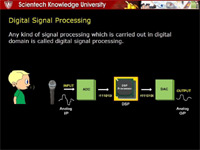Digital Signal Processing
DSP stands for Digital Signal Processing - the basis of many areas of technology, from mobile phones to modems and multimedia PCs. DSP is traditionally a highly mathematical subject, and the standard DSP textbooks contain a lot of mathematical exposition. This is necessary for a profound understanding of the subject. However, many people just want a simple introduction to the basic concepts and techniques of DSP. This courseware introduces the basic concepts of Digital Signal Processing by use of analogies, animations and examples.
Unit 1.1: Introduction of DSP
What is DSP, Basic elements of DSP and its Requirements, Advantages of digital signal processing over Analog Signal Processing ,Limitations of digital signal processing, Application of DSP.
Unit 1.2: What is Signal?
Continuous time signals, Discrete time signals, Digital (Discrete Value Signal) signals, Comparison of CT, DT and Digital Signal.
Unit 1.3: Representation of Signal
Representation of Discrete Time Signals,Some Elementary (Basic) Discrete Time Signals,Unit Impulse Signal,Unit Step Signal,Unit Ramp Signal,Exponential Signal,Sinusoidal Signal,Other Signals.
Unit 1.4: Classification of Signal
Classification of signal, Periodic and Non-periodic signals, Power and Energy Signal,Even and Odd signals, Deterministic and random signals, Multichannel and Multidimensional signals.
Unit 1.5: Sequence Operation
The identity sequence,Delay Operation, Multiplication by a constant.
Unit 1.6 : LTI
Importance,Properties of DT-LTI system,Causality , Stability,LTI System Response , Convolution,Definition and mathematical formulation,Properties of Convolution,Commutativity Property,Associative Property ,Distributive Property.
Unit 1.7: Discrete Time Systems
DT System and Classification, Static and Dynamic Time Variant and Time Invariant, Linear and Nonlinear, Causal and Noncausal, Stable and Unstable, Discrete Time system.
Unit 1.8 : Convolution
Convolution and Application of Convolution.
Unit 1.9: Correlation
Correlation, Cross Correlation and Auto Correlation, Properties of Auto and Cross Correlation, Application of Correlation.
Unit 2.1: Signal Analysis
Analysis of different type of signals.
Unit 2.2: Trigonometric Function
Importance of trigonometric function in DSP.
Unit 2.3: Fourier Series
Introduction ,Fourier Series,Definition and it’s need,Properties of Discrete Fourier series,Periodicity,Linearity,Duality,Complex conjugation of the periodic sequence.
Unit 2.4: Fourier Transform
Fourier Transform, Properties of Fourier transform, Problems in computation of FT.
Unit 2.5: DFT
Discrete Time Fourier Transform (DTFT) , Sampling in Time Domain, Definition of DTFT and its need , Properties of DTFT, Problems in computation of Inverse DTFT, Discrete Fourier Transform ,Sampling in Freq Domain, Relationship between DTFT and DFT, Computation of DFT and IDFT, Efficient way of computation of DFT and IDFT.
Unit 2.6: Properties of DFT
Properties of DFT, Linearity, Periodicity, Circular shift of a sequence and concept of Circular scale, Shift property of DFT.
Unit 2.7: Fast Fourier Transform
Basic Principle of FFT, Classification and types of FFTs ,Radix-2, Decimation in Time (DIT) FFT, The Butterfly, Algorithmic development ,Computational advantage and features ,Radix-2, Decimation in Frequency (DIF) FFT, The Butterfly, Algorithmic development, Computational advantage and features, Comparison of DIT and DIF ,Modifications to improve speed: Properties of FFTs.
Unit 3.1: Sampling
Introduction, Sampling in time domain and frequency domain, Sampling theorem, Effect of underselling aliasing, Over sampling, Under sampling, Discrete time decimation and interpolation, Quantization.
Unit 3.2: Quantization
Quantization, Need of Quantization, Quantization error or quantization noise, Encoding, Analog to Digital conversion Sample and hold, Quantization and coding, Analysis of quantization errors, Over sampling.
Unit 3.3: ADC and DAC Converters
Analog to Digital converters, Digital to Analog conversion.
Unit 4.1: Z Transform
Z-Transform, Definition and need of ZT, Single sided and Double sided Z transform, Region of convergence and its Role, Relation between Laplace Transform and ZT, Computation of ZT, Relation between ZT and FT, Inverse Z transform, Power Series method, Partial fraction expansion method ,Residue method, Application of ZT, System Analysis in Z-Domain.
Unit 5.1: Filter Design
Introduction to filter, Ideal Filter Characteristics, Need of Approximation of Ideal Filter Characteristics, Basic Analog filter approximations and Low Pass Filter design, Butterworth filter, Chebyshev filter ,Type I chebyshey filter, Type II chebyshey filter, Elliptic filter, Design of Normalized Low Pass Filter, Frequency Transformation for filter design.
Unit 5.2: IIR Filters
Frequency Transformation for filter design, Types of digital filter: FIR and IIR filter, Choosing between FIR and IIR filter.
Unit 5.3: FIR Filter Design
Introduction, Linear phase response and its implications, Types of linear phase FIR filter, Filter Design, FIR filter design specifications and Methods, Window method of FIR filter design, Steps Involved, Different Window functions and comparison, Frequency Sampling Method of FIR filter design, Type-I Filter Design, Type-II Filter Design, Other Methods, FIR Filter Realization structures , Finite word length effect.
Unit 5.4: Realization Structure of IIR filters
Introduction, IIR filter specification and steps involved in design, IIR coefficient calculation method, Impulse Invariant method, Bilinear transform, Comparison between impulse invariant and bilinear transform method, IIR Filter Realization Direct form I , Direct form II, Cascade form, Parallel form, Other forms, Finite word length effect ,Applications of IIR filter.
Unit 6.1: Embedded Systems
Unit 6.2: DSP Processors
Complete Course Rs 3640

 Add to Cart
Add to Cart 